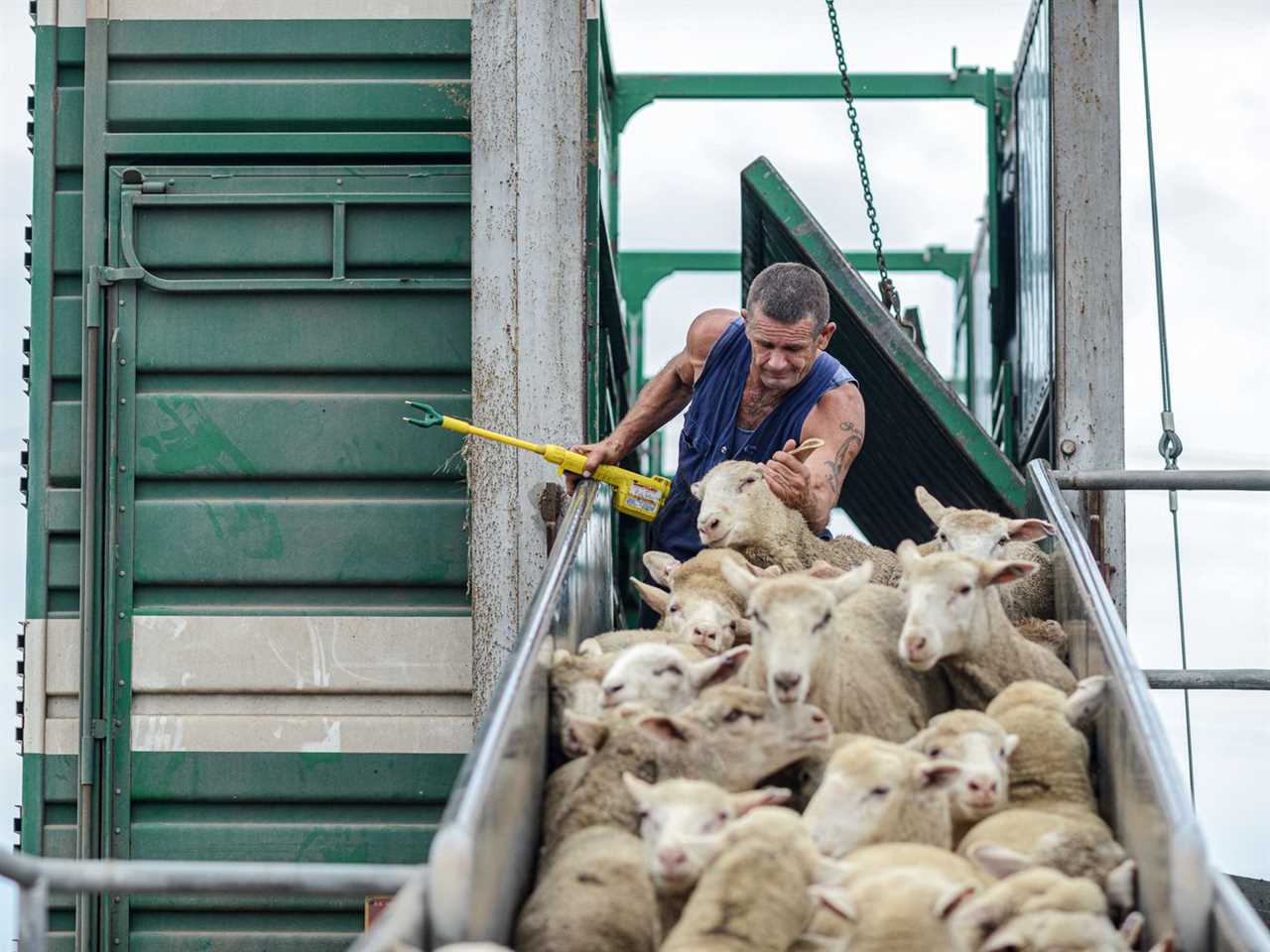
Farm animals starve and drown while shipped overseas for slaughter. Europe is considering a ban on the trade.
In 2019, a shocking accident at sea drew the world’s attention to one of the meat industry’s cruelest practices: the transport of live farm animals on long, perilous, and often fatal journeys by ship.
Late that year, the Queen Hind, an export ship carrying more than 14,000 sheep from Romania for slaughter in Saudi Arabia, capsized, resulting in the drowning of nearly every animal. Disturbing images emerged of the corpses of sheep floating in the Black Sea.
That sinking was one of the deadliest for animals in recent history, but it wasn’t unique. High-profile reports of animals drowned or abused on ships have prompted a growing movement in Europe and other regions to end the live export of farm animals for slaughter. While the global live animal trade isn’t a focus for the farm animal welfare movement in North America, where exports are relatively less common and tend to occur by land rather than sea, in Europe, it’s excoriated for its cruelty and has emerged as one of the most visible — and potentially winnable — fights for animal advocates.
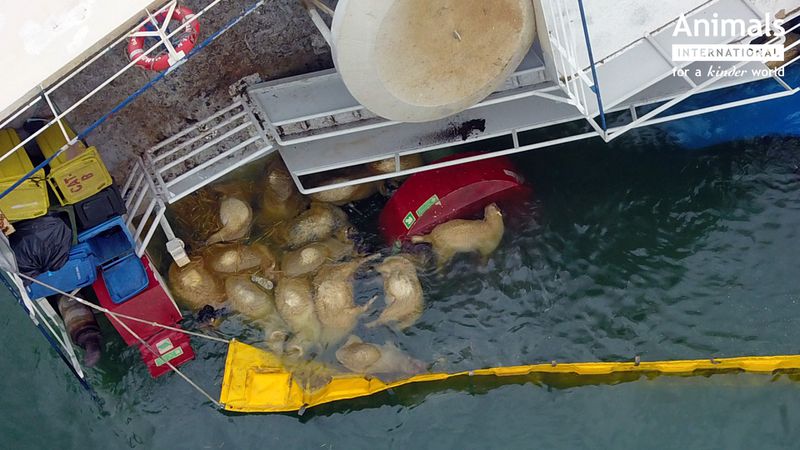
Animals International
Countries including Luxembourg and New Zealand recently banned the trade, and even Romania, a top sheep exporter, has been considering an end to the trade after the Queen Hind tragedy. In October, Germany became the biggest economy to announce it would end live export to countries outside the European Union, and called for an EU-wide ban on the practice. That came as a surprising policy reversal, given the importance of the livestock trade to the country. The EU is the world’s biggest livestock exporter, and Germany is one of the top players in that bloc, selling almost 315 million cattle, sheep, pigs, and poultry birds to other EU countries and almost 9 million animals outside the EU in 2019.
But the German government, according to its recent announcement, could “no longer stand by and watch as animals on long transports suffer or die in agony.”
Live animal export, explained
Almost 2 billion of the world’s 80 billion or so land animals raised for food every year, the majority of them chickens, are exported alive to different countries, according to 2021 data from the United Nations. This can happen for a host of reasons: In an interconnected global economy, farm animals are traded just like other commodities, and different countries have become hyper-specialized in different parts of the livestock supply chain. Some nations produce a surplus of animals — either deliberately or as a by-product of their livestock industries — which are exported to other buyers.
Male calves born into Ireland’s booming dairy industry, for example, have no value in dairy production because they can’t make milk, so they’re sold to the Netherlands or Spain for fattening and then either slaughtered for veal or exported again for slaughter elsewhere. Other countries specialize in breeding and exporting certain baby animals: Denmark, for example, is a leader in piglet exports.
And then there’s the demand side. Countries that can’t efficiently raise their own livestock because of limitations like low water supplies or warfare, like Libya, can find it cheaper to import animals, particularly when those animals come at a good price thanks to farm subsidies in their countries of origin. This also reduces the need for importing countries to refrigerate fresh meat.
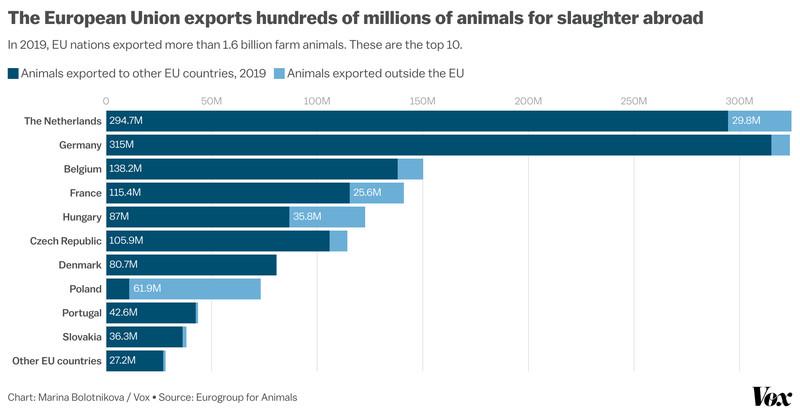
But animals aren’t inanimate widgets on a spreadsheet, and when they’re hauled hundreds of miles by land and sea, they’re treated as cargo, not passengers, which means their welfare is the least of anyone’s concerns.
And animal transport is inherently stressful. Trucks and ships are miserable places for animals to be crowded into, and painful tools like electric prods, boards, and sticks are used to force them on board. In the US, too, being trucked to slaughter is among the worst parts of a farm animal’s life. American truck transport conditions are so dire that, according to a recent analysis by the Guardian, more than 20 million animals die every year before they reach a slaughterhouse because of factors including physical trauma, slipping and falling in their own waste, lack of food and water, and extreme heat or cold.
As bad as being transported by land can be, sea transport is even worse, increasing the length of time animals spend in transit to weeks or even months.
“Livestock vessels are terrible places for animals,” said Caroline Rowley, founder of Ethical Farming Ireland, a nonprofit that has long campaigned against Ireland’s export of cows, calves, and other livestock. Most ships used to transport farm animals are past their prime, and there’s the added risk of stormy weather and sinking — something livestock vessels like the Queen Hind are estimated to do at twice the rate of standard freight ships. Delays at sea, which strain limited feed supplies and increase the buildup of excrement, stress, and injury, are another common risk.
Livestock ships are an animal welfare disaster
Although much of what happens at sea goes unnoticed by the public, a run of recent tragedies pushed livestock shipping into international headlines. After the Queen Hind accident in 2019, a company tasked with bringing the ship back to shore discovered secret, unauthorized decks on the vessel, raising concerns that it might have been carrying an unsafe number of animals. The Romanian government, which has helped the country become the EU’s top sheep trader, didn’t address allegations about secret decks but told me in a 2021 statement that the ship was carrying an appropriate number of animals.
In 2020, 41 people and nearly 6,000 cows died after the Gulf Livestock 1, a cargo ship traveling from New Zealand to China, capsized. In an interview last year, the girlfriend of one of the missing crew members said he had spoken of low food supplies on the ship. An investigation by Australia’s ABC cited concerns about the Gulf Livestock 1’s safety, and photos from an independent observer’s report produced for the Australian government revealed animals on the same ship in 2019 thoroughly covered in feces. The disaster galvanized protests against shipping animals, leading to New Zealand’s recent ban on live exports by sea.
Last year, another botched livestock shipment horrified the public in France: 780 bulls that had been sailing to Algeria had to be sent back due to a disagreement over their health paperwork — after which they were killed and disposed of. Similarly failed journeys were reported in 2021, when two ships from Spain bound for Turkey, the Elbeik and the Karim Allah, together carrying about 3,000 young bulls, were forced to return home after being stranded at sea for three months. The animals were killed on arrival without entering the food supply.
A veterinary report on conditions inside the Karim Allah detailed a range of welfare failures, including dead bulls being chopped up and thrown overboard, and animals with joint inflammation, skin conditions, eye ulcerations, abscesses, and broken horns. On the Elbeik, feces buildup was severe, and many bulls were found dead, starving, or dehydrated.
Even when a livestock ship arrives at its destination without incident, what happens next is just as controversial. In the EU, slaughter regulations typically require that animals be stunned to render them unconscious before killing to reduce pain and distress, but in North Africa and the Middle East, this is often avoided or limited in accordance with kosher and halal slaughter rules. Ritual slaughter laws are a highly contentious issue both in European politics and in the animal movement, contributing to debates about religious liberty, pluralism, and animal welfare. And in many countries, halal rules are evolving: In Turkey, for example, more halal butchers are embracing stunning before slaughter.
Activists often use videos of slaughter abroad to draw attention to what they see as the horrors of live export. Just ahead of Germany’s announcement that it would end exports, the minister of food and agriculture, Cem Özdemir, received undercover footage from the organization Animals International that appeared to show workers in two Lebanese slaughterhouses using ropes to bring cows down onto an already bloody floor. The cattle, identified as German by their ear tags, slip on the floor, have fingers pushed into their eye sockets and, once down, have one leg hoisted upward to immobilize them before their throats are cut. (These apparent abuses aren’t tied to halal slaughter; rather, they reflect cruelty that’s common anywhere in the world where animals are slaughtered.)
The German agricultural ministry, responding to my questions about the video for a previous story, did not reference it directly but said it was “unbearable” to see “pictures of dead and injured animals during animal transport and of other animal welfare violations in third [non-EU] countries.”
More nations are banning live export — but that may not be enough
Ending live exports is popular with the public: A recent report on EU animal protection laws found that 94 percent of citizens surveyed supported ending animal shipments to non-EU countries.
The animal trade poses serious human health concerns, too, that might make EU nations inclined toward a ban: Long animal transport times are known to increase the risk of antibiotic resistance, a recent EU report noted — a problem that the continent has been making a concerted effort to address. “Every time you transport animals, you create opportunities for disease spread,” said Ann Linder, a research fellow at Harvard Law School studying zoonotic disease. “Stress lowers immunity, and poor ventilation in trucks also helps spread … there is a real risk of pathogens lingering on surfaces, so you are potentially bringing healthy animals into a contaminated environment, and then locking them in there.”
So far, the route to a ban has been different for each country. In New Zealand, the loss of human life on the Gulf Livestock 1 was a defining moment. In Germany, activists have had a sympathetic ear in agriculture minister Özdemir, a vegetarian who, as Vox has reported, has championed efforts to make Germany more plant-based.
Unsurprisingly, European livestock producers vehemently oppose a ban on live animal exports and have argued the trade boosts livestock prices by creating more demand for their products. And even for European countries that have prohibited live export to non-EU states, there’s a catch: re-export. Because EU member countries can’t ban exports to each other, nations that restrict animal exports out of the EU can simply sell animals to countries without one. Under Germany’s ban, for example, the sale of cattle to Spain will continue unimpeded. From Spain, where no ban exists, animals are fattened and shipped to non-EU countries for slaughter.
Spain is one of the EU’s key fattening and re-export hubs. Although the Spanish agriculture ministry did not respond to questions for this story, recent government data shows the country exports hundreds of thousands of animals annually to the Middle East, North Africa, and Latin America. A 2022 EU report put the annual value of Spain’s beef exports at about $1.2 billion, of which 35 percent is live animals.
To keep the beef trade flowing, Spain buys calves from all over Europe, making it the region’s biggest importer. The country imported 292,000 calves per year between 2015 and 2020, according to the same EU report. One of Spain’s key sources is Ireland, whose dairy industry was worth $5.5 billion in 2021.
To produce that much milk, the Irish dairy sector impregnates its almost 1.6 million dairy cows every year. Since half their offspring are male and unable to produce milk, they’re eventually slaughtered for meat. Some of the calves remain in Ireland and are reared for beef, but tens of thousands are exported for meat or veal production in other EU countries.
Ireland’s island geography means that process involves a journey of at least 18 hours, inside trucks parked on ferries bound for the nearest EU mainland ports in France. From there, the calves are typically trucked to the Netherlands or Spain. Trucks don’t have milk for the calves, so they make the 18-hour ferry journey, plus a few hours for collection and waiting time on either side, without food. A 2020 video, taken by the European animal welfare groups L214 and Eyes on Animals, showed weeks-old calves arriving in France, apparently desperate to nurse, being beaten and kicked to get them off of feeders provided at rest-stops.
In response to questions from Eyes on Animals, the European Commission, the EU’s executive branch, suggested that failure to feed calves on such long journeys violated EU regulations. But Ireland has continued to ship calves overseas without food, exporting over 220,000 of them last year.
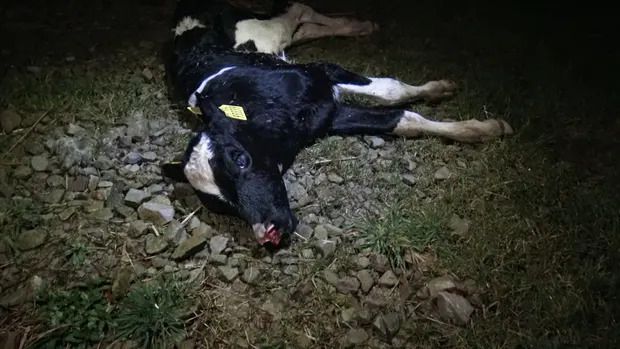
Eyes on Animals/L214
Rowley of Ethical Farming Ireland (EFI) said her group regularly sends evidence of problems with live export to the Irish government, “but the department repeatedly ignores us, or sends platitudes in return.”
EFI and three other NGOs sent an open letter to Ireland’s Department of Agriculture, Food, and the Marine in November, asking for a face-to-face discussion about the possibility of Ireland following Germany’s lead in banning exports outside the EU. “While the Germans are restricting live exports, our government is expanding them, actively seeking new markets,” Rowley said. “It’s totally the wrong direction.”
In an email to Vox, the Irish government said that its “work in this area is conducted on the basis that no one shall transport animals, or cause animals to be transported, in a way likely to cause injury or undue suffering.”
The UK in 2020 promised to end live exports and is expected to soon enact a ban, which might motivate the Irish government to do the same, Rowley said. But an EU-wide ban was equally or potentially more important, she added.
An EU-wide ban might soon be within reach
While individual country bans are helpful, only an EU-wide ban can close the re-export loophole and prevent long shipments and slaughter without stunning, said Gabriel Paun of Animals International.
“The ethical, economical, and social benefits for the EU to ban live export are clear,” Paun said. Those advantages, he said, include not just mitigating unnecessary suffering, but also the economic benefits of killing and processing animals in Europe instead of sending them to other countries to do the slaughtering. The biggest hurdle, he added, is the myth that Middle Eastern countries with halal regulations would rather import live animals than accept meat slaughtered elsewhere. The reality, based on Paun’s experience in those nations, is that packaged halal meat is already being imported and that people don’t want to import “dirty, wounded [EU] animals.”
Similarly, in Israel, where animals are slaughtered according to kosher laws, the public is alarmed by the treatment of imported animals, and multiple bills have been introduced in the Israeli parliament to ban the trade, according to Hila Keren of Animals Now, an Israeli NGO. “A survey conducted in Israel showed that 86 percent of the public support the legislation and 91 percent believe live export involves cruelty to animals,” said Keren. “The price of imported chilled and frozen beef is generally cheaper than the meat of cows slaughtered in Israel,” she added.
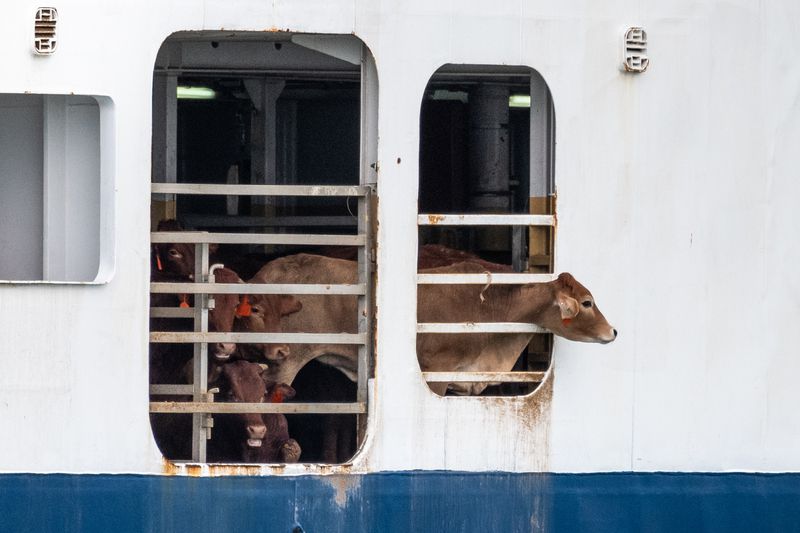
Jo-Anne McArthur / Israel Against Live Shipments / We Animals Media
An opening for a European live export ban is not far off, with an overhaul of the EU’s animal welfare and transport laws scheduled for late this year. Countries expected to support ending live exports include Germany, Belgium, Denmark, the Netherlands, and Sweden, given that all five recently called for greater restrictions on animal shipments outside the EU. Luxembourg, which banned live animal exports last March, is another supporter.
But opposition is significant. Nations with ports that move large numbers of animals, including Spain, France, Ireland, and Romania, are likely to object to a ban, said Anja Hazekamp, a Dutch European Parliament member and vice chair of a recent animal transport inquiry.
The Spanish agriculture ministry did not respond to questions about export bans. The French government said it “remains opposed to a ban on the export of live animals to third countries for fattening/slaughter,” adding that it would “pay attention” to the upcoming EU revision of animal protection laws.
Ireland’s government didn’t answer questions about whether it would support an EU-wide ban but told Vox that it “demands the highest standards of animal welfare during transport” and “facilitates [live export], recognizing its critical importance to the agri-sector.”
Despite the intransigence of live-exporting nations, Germany’s move to end direct exports to non-EU countries, along with this year’s EU talks, represents the strongest opportunity yet for a change of direction. The outcome will ultimately depend on negotiations between EU countries and a majority vote; a ban could pass over the objections of live-exporting nations.
Arguments for a ban are currently being tested in Romania, a country that exported over 1.8 million sheep outside the EU in 2019. Dragoş Popescu, a progressive senator there, has championed legislation to end live exports by 2025. But he’s faced steep challenges, with his own party deserting him on the issue, which meant he had to introduce the bill by himself in December, he told Vox.
The challenge is to make people aware of live export’s cruelty, he said. “People don’t know about the treatment of the animals. We will need a campaign to raise awareness,” Popescu explained. His campaign will aim to build on the Queen Hind tragedy. “People were shocked by the Queen Hind, by the reality of live export,” he said.
Hopeful as he is, a recent WhatApp message from Popescu reflected just how difficult the fight might be: “The debate [on the bill’s introduction], as expected, was hard. The sheep owners were very loud,” he wrote, adding a bullhorn emoji.
----------------------------------------
By: Sophie Kevany
Title: The biggest animal welfare crisis you’ve never heard of
Sourced From: www.vox.com/future-perfect/23552817/live-animal-export-europe-queen-hind
Published Date: Mon, 16 Jan 2023 12:00:00 +0000
Did you miss our previous article...
https://consumernewsnetwork.com/politics-us/doj-presents-case-against-proud-boys-leaders-for-leading-the-capitol-breach






